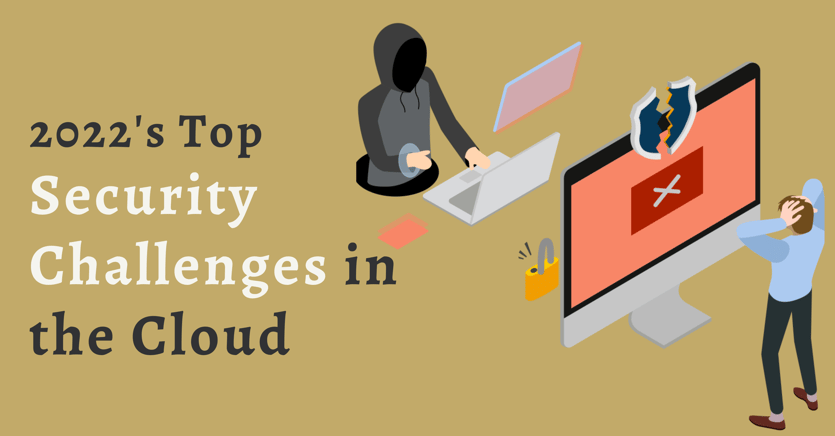2022's Top Security Challenges in the Cloud

Building client solutions on the cloud is an excellent idea. A decade ago, it would have been impossible to obtain the present levels of technology. It's now possible to create a virtual data centre with only a single command. Teams around the world have benefited from this ability. On-premise security concerns were expected to arise without amplification. Zero-day vulnerabilities and "Shadow IT" are issues that should be taken into consideration. In the end, it appears that they aren't, or at least those issues aren't high on their list of priorities. Developers face the most significant cloud security risk. Misconfiguration faults are their main problem. But first, let's take a closer look at the data underlying the most widespread misperception about cloud security. They view cloud computing providers as a significant security threat. It's clear from the data that this is not the case.
In the last five years, all cloud service companies have suffered at least two security breaches. The great majority of cloud services are just managed service solutions of well-known commercial or open-source projects. On these projects, vendors are confronted with a slew of security issues. Users and developers alike benefit from the cloud's features. The shared responsibility model governs all operational tasks in the cloud, including security. Your responsibilities may change depending on the cloud service you use. If you utilise instances or virtual machines, you are solely responsible for your data and operating system. Your data processing and storage, as well as the service configuration, is still your responsibility when using fully managed services. When it comes to meeting your commitments and customising your service, suppliers are now offering a wide range of options.
Misconfigurations are the primary threat to cloud security, and we now have further evidence to support this claim. A misconfiguration is at the root of 65-70 percent of all cloud security concerns, according to researchers from various security companies or industry associations, but surveys and specialist research studies can only go so far. Are there any facts to back this up? There are reports of non-cloud hacks and breaches if you remove them from the equation. As a result, the problem wasn't with the cloud per se, but rather with the provider of the service. Over 2 billion confidential records were still at risk due to a flaw in the cloud's security. Delete any breaches that weren't the result of a single setting error. Most of the breaches were the result of a single misconfiguration, erroneous authorization, or other tiny oversight.
This event was complicated by two misconfigurations and one defect. This issue had no bearing on the total consequence of the breach of 100 million customer records, according to our investigation. A seasoned user of the cloud, Capital One is as well. One of the world's most popular open-source cloud security management programmes, is a reference client for a major cloud vendor, as well as a community advocate for cloud computing. This is an accomplished group. But they made a mistake. Those are misconfigurations, errors, omissions, and, in some cases, incorrect decisions that were made out of ignorance.
For example, teams may innovate more quickly because to the power of the cloud, which allows them to maintain a high rate of innovation with low failure rates as they grow. More than a third (33%) of DevOps teams can reliably deploy at least once per week with a failure rate less than 15%, and more than half (46%) of these teams can fix errors within a day. Hackers don't care what day it is. An incident can be caused by exploiting any hole in the system. Slower teams, on the other hand? In contrast, the remaining 57% of units, most of which belong to large firms, are protected by their slowness. They can reduce errors by moving gradually into the cloud. That being said, no data exists to prove or disprove this notion. Even the cloud service providers are undergoing fast change. There are approximately two new features added every day for a single cloud user, and as the number of multi-cloud clients grows, this rate will only increase. In other words, even if your crew travels slowly, the terrain beneath them is constantly changing at a rapid pace.
The goal of cybersecurity is as straightforward as it is complex. The end goal is to create a product that does exactly what it is supposed to do. On-premises, as well. This tried-and-true method creates an impenetrable barrier around the business. That doesn't work online because both the supplier and the internals are constantly changing. The number of smaller teams is increasing, and they are often operating outside of the CIO's control. Treating security as part of building effectively rather than a separate endeavour is essential. This appears to be an enormous undertaking.
Ransomware crypto miners can be stopped by anti-malware. We've compiled a list of the components of each security control. The security team, for example, will appreciate this, but developers have a different point of view they'd like to implement. In the correct environment, security limitations can aid in their development. In addition to preventing things from happening, security measures can also ensure that the right container is installed at the right moment and that only valid traffic reaches their code. What else is there for them to do? Security precautions have resulted in a decrease in traffic. Extreme Compute's security safeguards help teams build better on the cloud. Security is a major factor in cloud computing's advancement.
